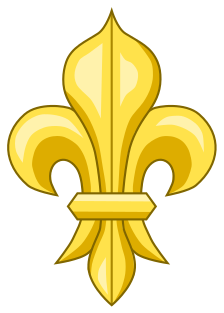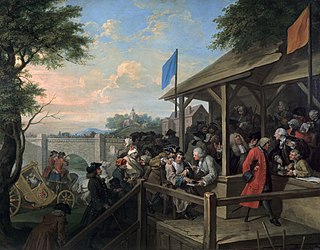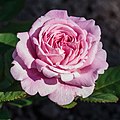
A rose is a woody perennial flowering plant of the genus Rosa, in the family Rosaceae, or the flower it bears. There are over three hundred species and tens of thousands of cultivars. They form a group of plants that can be erect shrubs, climbing, or trailing, with stems that are often armed with sharp prickles. Their flowers vary in size and shape and are usually large and showy, in colours ranging from white through yellows and reds. Most species are native to Asia, with smaller numbers native to Europe, North America, and northwestern Africa. Species, cultivars and hybrids are all widely grown for their beauty and often are fragrant. Roses have acquired cultural significance in many societies. Rose plants range in size from compact, miniature roses, to climbers that can reach seven meters in height. Different species hybridize easily, and this has been used in the development of the wide range of garden roses.

The fleur-de-lis, also spelled fleur-de-lys, is a lily that is used as a decorative design or symbol.

The State Flag of the Union of Soviet Socialist Republics, commonly known as the Soviet flag, was the official state flag of the Union of Soviet Socialist Republics (USSR) from 1922 to 1991. The flag's design and symbolism are derived from several sources, but emerged during the Russian Revolution. The flag is also an international symbol of the communist movement as a whole.

The hammer and sickle is a symbol meant to represent proletarian solidarity – a union between the peasantry and the working class. It was first adopted during the Russian Revolution, the hammer representing workers and the sickle representing the farmers.

In politics, a red flag is predominantly a symbol of socialism, communism, Marxism, trade unions, left-wing politics, and historically of anarchism. It has been associated with left-wing politics since the French Revolution (1789–1799).

Political colours are colours used to represent a political ideology, movement or party, either officially or unofficially. It is the intersection of colour symbolism and political symbolism.

The flag of Georgia, also known as the Five Cross Flag, is one of the national symbols of Georgia. Originally a banner of the medieval Kingdom of Georgia, it was repopularized in the late 20th and early 21st centuries during the Georgian national revival.

The national emblem of Belarus features a ribbon in the colors of the national flag, a map of Belarus, wheatears and a red star. It is sometimes referred to as the coat of arms of Belarus, although in heraldic terms this is inaccurate as the emblem does not respect the rules of conventional heraldry. The emblem is an allusion to one that was used by the Byelorussian SSR, designed by Ivan Dubasov in 1950, with the biggest change being a replacement of the Communist hammer and sickle with an outline map of Belarus. The Belarusian name is Dziaržaŭny herb Respubliki Biełaruś, and the name in Russian is Gosudarstvennyĭ gerb Respubliki Belarusʹ.

A red star, five-pointed and filled, is a symbol that has often historically been associated with communist ideology, particularly in combination with the hammer and sickle, but is also used as a purely socialist symbol in the 21st century. It has been widely used in flags, state emblems, monuments, ornaments, and logos.

The White Rose of York is a white heraldic rose which was adopted in the 14th century as an heraldic badge of the royal House of York. In modern times it is used more broadly as a symbol of the county of Yorkshire.

The Red Rose of Lancaster was the heraldic badge adopted by the royal House of Lancaster in the 14th century. In modern times it symbolises the county of Lancashire. The exact species or cultivar which it represents is thought to be Rosa gallica officinalis.
The raised fist, or the clenched fist, is a long standing image of mixed meaning, often a symbol of political solidarity. It is also a common symbol of communism, and can also be used as a salute to express unity, strength, or resistance.
In a number of countries, plants have been chosen as symbols to represent specific geographic areas. Some countries have a country-wide floral emblem; others in addition have symbols representing subdivisions. Different processes have been used to adopt these symbols – some are conferred by government bodies, whereas others are the result of informal public polls. The term floral emblem, which refers to flowers specifically, is primarily used in Australia and Canada. In the United States, the term state flower is more often used.

The Anti-Socialist Laws or Socialist Laws were a series of acts, the first of which was passed on 19 October 1878 by the Reichstag lasting until 31 March 1881 and extended four times.

Socialist state emblems usually follow a unique style consisting of communist symbolism. Although commonly referred to as coats of arms, most are not actually traditional heraldic achievements. Many communist governments purposely diverged from heraldic tradition in order to distance themselves from the monarchies that they usually replaced, with coats of arms being seen as symbols of the monarchs.
The German Strafgesetzbuch in section § 86a outlaws "use of symbols of unconstitutional organizations" outside the contexts of "art or science, research or teaching". The law does not name the individual symbols to be outlawed, and there is no official exhaustive list. However, the law has primarily been used to outlaw Nazi, Communist, and Islamic extremist symbols. The law was adopted during the Cold War and notably affected the Communist Party of Germany, which was banned as unconstitutional in 1956, the Socialist Reich Party and several small far-right parties.
Communist symbolism represents a variety of themes, including revolution, the proletariat, peasantry, agriculture, or international solidarity.

Upon its liberation in 1945 and subsequent foundation in 1948, North Korea adopted national symbols distinct from the national symbols of South Korea. The traditional flag of Korea, the Taegukgi, and the symbol Taeguk, were swapped for communist symbols.

The Three Arrows is a social democratic political symbol associated with the Social Democratic Party of Germany (SPD), used in the late history of the Weimar Republic. First conceived for the SPD-dominated Iron Front as a symbol of the social democratic resistance against Nazism in 1932, it became an official symbol of the Party during the November 1932 German federal election, representing opposition towards Nazism, communism and reactionary conservatism.























